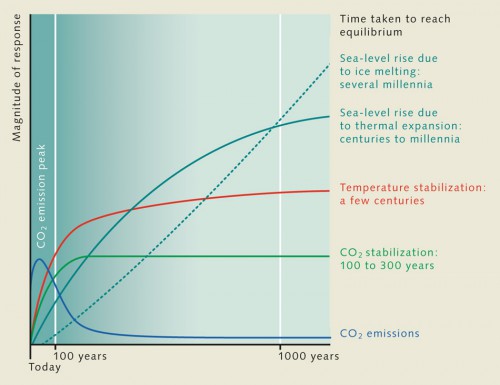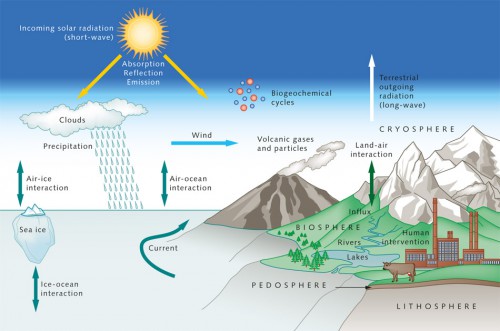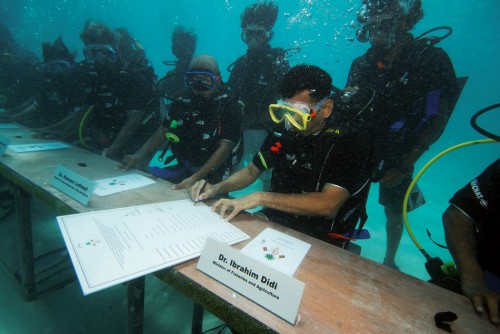
Earth’s climate system – a complex framework
 1.1 > Different components of the climate system react to perturbations at different rates. The deep ocean, for example, is an important cause of the slow response of climate. The coloured area on the top scale represents the short time span of a human life.
1.1 > Different components of the climate system react to perturbations at different rates. The deep ocean, for example, is an important cause of the slow response of climate. The coloured area on the top scale represents the short time span of a human life.The inertia of climate
As we all learned in school, the world’s oceans are one of the most important elements in the global climate system. But what does “climate” actually mean? The difference between weather and climate can be expressed in a single sentence: “Climate is what you expect; weather is what you get.” This reveals a fundamental difference between weather and climate. Weather research is concerned with the formation, movement, and prediction of the individual elements of weather, such as a particular low-pressure system or a hurricane. Climate research, on the other hand, deals with the more comprehensive totality of low pressure systems and hurricanes, and is dedicated to addressing questions such as how many midlatitudinal storms or hurricanes will occur next year, or whether they will become more frequent or intense in the coming years as a result of global warming. So the term “weather” refers to short-term events in the atmosphere, while “climate” relates to longer time periods. For describing climate, as a rule, a time span of 30 years is generally used as a frame of reference.
- People mainly perceive climate change as changes in atmospheric variables, for example, variations in temperature or precipitation. In principle, due to its chaotic dynamics, the atmosphere itself can generate many natural climatic changes. One example of this is the North Atlantic oscillation (NAO), which significantly influences the climate over parts of Europe and North America. It is a kind of pressure fluctuation between the Icelandic Low and the Azores High that determines the strength of winter westerly winds across the North Atlantic. If these are strong, the result is mild and rainy weather in Western Europe; if they are weak it is dry and cold. These kinds of natural oscillations make it difficult to recognize anthropogenic climate changes due to an enhanced greenhouse effect.
The atmosphere is not an isolated system. It interacts with other components of the Earth system – the oceans, for example. But it is also in contact with the cryosphere (ice and snow), the biosphere (animals and plants), the pedosphere (soil) and the lithosphere (rocks). All of these elements together compose the climate system, whose individual components and processes are connected and influence each other in diverse ways.
- The atmosphere is not an isolated system. It interacts with other components of the Earth system – the oceans, for example. But it is also in contact with the cryosphere (ice and snow), the biosphere (animals and plants), the pedosphere (soil) and the lithosphere (rocks). All of these elements together compose the climate system, whose individual components and processes are connected and influence each other in diverse ways.
Extra Info The difficulty of detecting anthropogenic climate change

- These components all react to change at different rates. The atmosphere adjusts to the conditions at the Earth’s surface such as ocean temperature or ice cover within a few hours to days. Furthermore, weather is variable and can only be predicted a few days in advance. In fact, it has been shown that the theoretical limit of weather predictability is around 14 days. Currents in the deep sea, however, require several centuries to react fully to changing boundary conditions such as variations in the North Atlantic oscillation, which cause changes in temperature and precipitation at the sea surface and thus drive motion at greater depths. A large continental ice mass such as the Antarctic ice sheet, as a result of climate change, presumably undergoes change over many millennia, and without counteractive measures it will gradually melt on this time scale. The predictability of climate is based on the interactions between the atmosphere and the more inert climate subsystems, particularly the oceans. Within this scheme, the various components of the climate system move at completely different rates. Low-pressure systems can drift hundreds of kilometres within days. Ocean currents, on the other hand, often creep along at a few metres per minute. In addition, the individual components possess different thermal conductivities and heat capacities. Water, for instance, stores large amounts of solar heat for long periods of time.
Climate changes can be triggered in two different ways – by internal and external forces. The internal forces include:- Changes in a single climate component, for example, an anomalous ocean current;
- Changes in the interactions between different climate components, for example, between the ocean and atmosphere.
- The very slow drift of continents, which moves land masses into different climate zones over millions of years;
- The changing intensity of radiation emitted by the sun. The radiation energy of the sun fluctuates over time and changes temperatures on Earth;
- Volcanic eruptions, which inject ash and sulphur compounds into the atmosphere, influence the Earth’s radiation budget and thus affect climate.
Carbon dioxide and the greenhouse effect The atmosphere is becoming more enriched in carbon dioxide (CO2), or to be more precise, carbon dioxide and other climate-relevant trace gases. Initially they allow the incoming short-wave radiation of the sun to pass through. This energy is transformed to heat at the Earth’s surface and is then emitted back as long-wave radiation. The gases in the atmosphere, like the glass panes of a greenhouse, prevent this long-wave radiation from escaping into space, and the Earth‘s surface warms up.
How humans are changing the climate
The human impact on climate has greatly increased over the past hundred years. We release vast amounts of climate-relevant trace gases into the atmosphere. This changes the radiation balance of the atmosphere and leads to global warming.
In addition to carbon dioxide, these trace gases include methane, nitrous oxide (laughing gas), halogenated fluorocarbons, perfluorinated hydrocarbons, and sulphur hexafluoride. But carbon dioxide (CO2) is especially important for the Earth’s climate system because the worldwide output is so enormous. It is released primarily through the burning of fossil fuels (oil, natural gas, and coal) in power plants, vehicle engines or in household heating systems. Its atmospheric levels have risen to almost 390 parts per million (ppm) today as compared to the pre-industrial value of 280 ppm. With this increase the temperature has also risen during the twentieth century. The internally driven changes in the oceans such as changes in the Gulf Stream also occur within a time frame of decades or a few centuries. These have a decisive influence on climate and on the concentration of greenhouse gases in the atmosphere because they are strongly involved in global mass cycles such as the carbon cycle. For example, CO2 dissolves easily in water. However, the oceans have taken up about half of all the carbon dioxide produced by the burning of fossil fuels since the beginning of the industrial revolution, which has clearly dominated the natural variations. Whether the climate will change in the future, and by how much, can therefore be also deduced from the oceans.
- Climate will change very slowly in the future because the oceans with their immense volumes of water react very gradually to change. Therefore, many but not all of the consequences of climate change triggered by human activity will only gradually become noticeable. Some of these consequences could actually be irreversible when certain thresholds are crossed. At some point it will no longer be possible, for instance, to stop the complete melting of the Greenland ice sheet and the resulting seven-meter rise of sea level. The position of the threshold, however, is not precisely known. But one thing is certain: Even if the emission of carbon dioxide were stabilized at today’s levels it would not lead to a stabilization of the carbon dioxide concentration in the atmosphere, because carbon dioxide is extremely long-lived and the carbon dioxide sinks, mainly the oceans, do not absorb it as quickly as we produce it.
The situation is different for short-lived trace gases like methane (CH4). If methane emissions were stabilized at the present level, the methane concentration in the atmosphere would also stabilize, because methane diminishes in the atmosphere at about the same rate as it is emitted. In order to maintain the carbon dioxide concentration at a given level, the emissions have to be reduced to a fraction of the present amounts.
- 1.4 > Even if it is possible to significantly reduce the emission of greenhouse gases, and CO2 in particular, by the end of this century, the impact will still be extensive. CO2 has a long life and remains in the atmosphere for many centuries. Because of this, the temperature on the Earth will continue to rise by a few tenths of a degree for a century or longer. Because heat penetrates very slowly into the ocean depths, the water also expands slowly and sea level will continue to rise gradually over a long period of time. Melting of the large continental ice sheets in the Antarctic and Greenland is also a very gradual process. Melt water from these will flow into the ocean for centuries or even millennia, causing sea level to continue to rise. The figure illustrates the principle of stabilization at arbitrary levels of CO2 between 450 and 1000 parts per million (ppm), and therefore does not show any units on the response axis

A looming catastrophe
Long after the stabilization of carbon dioxide levels, the climate will still further continue to change because of its inertia. Climate models indicate that the near-surface air temperature will rise for at least a hundred years. Sea level will continue to rise for several centuries because seawater expands slowly as a result of the gradual warming of the deep sea, and because the continental ice sheets in the Arctic and Antarctic will probably react very slowly to the warming of the atmosphere, and the glaciers will continue to melt for many millennia. It will therefore be a long time before sea level achieves a new equilibrium. But scientists also believe it is possible that, if the warming is strong, the Greenland ice sheet could completely melt within this millennium and disappear into the ocean. The ice sheet could actually break apart and giant pieces fall into the sea. The enormous amounts of fresh water could cause a critical change in ocean circulation, for example, in the Gulf Stream. In an extreme scenario, sea level could rise by more than a metre per century, regionally by even more.
The inertia of the climate system and the danger that the trend is irreversible should be sufficient reasons for forward-looking action. One should always keep in mind that the impacts of climate change that are measurable today do not yet reflect the total extent of climate change already caused by humans in the past. Humankind will only begin to feel them sharply in a few decades but has to take action right away.

